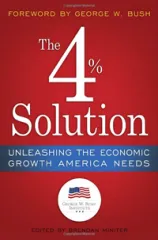The decade’s significant expansion of interventionist policies counteracted the relatively modest reductions in marginal tax rates. And as the size and scope of government power increased, the economic freedom of the typical citizen declined. To reverse this trend, we should look to the following: spending reductions to bring spending in line with taxation; entitlement reform to put the nation’s budget on a sustainable course; tax reform to close loopholes and reduce rates such as the corporate tax rate; financial reforms to finally end too big to fail; regulatory reforms to reduce distortions in the marketplace; health care reforms so that market forces can actually operate in that industry; and other economic reforms to restore a level playing field in American business.
One of the most prominent lines in the current economic debate warns of a return to the ‘free market’ policies that were pursued in the years before the Great Recession: “The worst thing we can do is go back to the same failed policies that got us into this mess in the first place.” Matthew Mitchell, senior research fellow at the Mercatus Center, says this argument is fundamentally flawed: “The notion that the decade before the Great Recession was a heyday of free-market capitalism is absurd. On nearly every dimension other than tax rates, federal policy became less market oriented. Spending exploded. Trade barriers went up. And government picked winners and losers. “The problem with this argument is that it assumes tax policy is the only measure of a free market. It wholly ignores the decade’s spending, regulation, trade, monetary, and industrial policy. “But the argument persists because neither side has an incentive to expose its faults. The left does not want to admit that government exploded in size and scope in the years leading up to the recession. And the right does not want to admit that this happened under a Republican watch.” Here are the facts: Spending and Debt Federal spending as a share of GDP leapt from 18.2 percent in 2001 to 25.2 percent in 2009. This was the largest such increase in any 8-year period since WWII. Net federal debt went from 32.5 percent of GDP in 2001 to 54.1 percent of GDP in 2009, a post-WWII high. Keynesian Fiscal Policy The Bush Administration was far more aggressive than its predecessors in pursuing discretionary, Keynesian-style counter-cycle fiscal policy. There were no fewer than four such measures during the Bush years: cash rebates in 2001; investment incentives known as “bonus depreciation” in early 2002; tax rebates in 2003; and the 2008 stimulus which included more rebates. Expanded Size and Scope of Government Power
The decade’s significant expansion of interventionist policies counteracted the relatively modest reductions in marginal tax rates. And as the size and scope of government power increased, the economic freedom of the typical citizen declined. Politicians genuinely interested in avoiding the “same failed policies” pursued in the run-up to the Great Recession should be striving to enhance economic freedom; instead, they’ve managed to further undermine it. The stimulus bill of 2009, the selective enforcement of standard bankruptcy procedures, the Dodd-Frank Act, and the Affordable Care Act have only hastened the decline in U.S. economic freedom. To reverse this trend, we should look to the following: spending reductions to bring spending in line with taxation; entitlement reform to put the nation’s budget on a sustainable course; tax reform to close loopholes and reduce rates such as the corporate tax rate; financial reforms to finally end too big to fail; regulatory reforms to reduce distortions in the marketplace; health care reforms so that market forces can actually operate in that industry; and other economic reforms to restore a level playing field in American business. |
